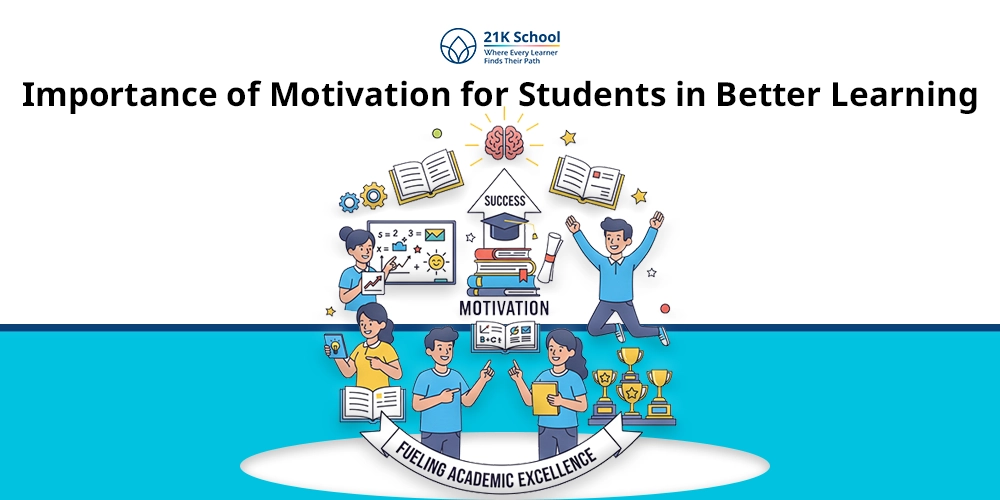
What does your ideal space look like when you’re fully focused on working and learning something new?
Does it look like an organised table with all your favourite books/tools, your room filled with natural light coming from the window, or your go-to playlist playing in the background?
We sometimes do not consider the environment important but it plays a significant role in how properly you learn things, grab the information, and stay engaged.
No matter whether it is a physical classroom or a homeschooling setting, creating a positive environment is very important as it affects the overall experience and academic performance of the student.
Today, in this blog we will talk about what is a positive learning point, why it is important and 10 ways to create a positive learning environment.
Contents
- What Positive Learning Environment?
- Why is a Positive Learning Environment Important?
- Characteristics of a Positive Learning Environment
- 16 Ways to Create a Positive Environment
- 1. Build positive relationships
- 2. Creating routines
- 3. Provide positive reinforcement
- 4. Clear communication
- 5. Encourage collaboration
- 6. Priorities social emotional learning
- 7. Sharing personalized assignment feedback
- 8. Provide flexibility
- 9. Create rules and expectations
- 10. Be open to feedback
- 11. Inquiry-Based Learning
- 12. Differentiated Instruction
- 13. Positive Language
- 14. Create a Welcoming Physical Space
- 15. Celebrate Success
- 16. Model Positive Behaviours
- Positive Learning Environment Examples
- Difference Between a Positive Learning Environment and a Negative Learning Environment
- Conclusion
What Positive Learning Environment?
Positive learning environment can be defined as a space, which may either be physical or virtual, where students feel motivated, safe, and supported whenever needed.
It does not matter the type of room or technology that is used; it is the environment that fosters development, discovery and engagement.
In such environments, learners feel at ease to share their thoughts, ask questions and take academic risks without being judged.
Constructive learning environments are characterised by mutual respect, open communication, and concern about emotional as well as intellectual growth.
It is a place where students are appreciated and felt important, hence improving their morale to study.
Why is a Positive Learning Environment Important?
A positive learning environment is not just a comfortable space but a frame of mind and overall atmosphere that promotes learning, growth, and emotional development of the individuals concerned.
If learners feel safe, supported and encouraged they gain confidence and get to perform better in their academics.
A welcoming environment enables the students to exercise some risks of expressing themselves and open their arms to challenges without having a fear of being pulled down by the negative judgement.
Also, it improves interpersonal relationships and boosts communication, making collaboration more engaging. Positive learning environment is not only about reducing pressure — it’s about making learning enjoyable and empowering for everyone involved.
Characteristics of a Positive Learning Environment
A positive learning environment helps in promoting a healthy learning environment and promotes dynamic education. Building a positive learning environment allows to develop trust and engagement of students.
This ensures that every student from any background can achieve equal learning opportunities without any hindrances.
Here you can check the characteristics of a positive learning environment mentioned below.
1. Safe Environment
A positive learning environment allows students to feel safe and comfortable in a school environment. A safe atmosphere promotes student mental health and makes them socially responsible.
A safe environment can be created by preventing bullying, discrimination, racism and disagreements between students, which allows them to feel safe and comfortable.
This also enhances the learning outcomes of students and enhances their confidence by eliminating racial problems in schools.
2. Develop Mutual Respect
A positive learning environment allows students to develop respect, sympathy, and feel valued towards others. Respecting others helps to participate in class activities and develops better learning experiences.
A positive academic environment allows students not to be afraid of making any statements or mistakes.
This allows students to develop confidence and enhance their participation as well as understand the benefits of inclusive learning.
3. Promotes an Inclusive Environment
A positive learning environment allows for an inclusive learning environment in schools and institutions.
Inclusive learning allows individuals to effectively communicate with others and breaks the stereotypes of discrimination and inequality.
Through creating a positive atmosphere, students can develop respect and sympathy towards others, which enables them to develop social skills.
4. Enhance Teacher-Student Relationship
It is also seen that positive and equal learning opportunities enable students to engage in the classroom learning process.
This also enables teachers to develop interactive class sessions and give students autonomy and flexibility. This allows them to build teacher-student relationships and makes education more accessible.
5. Enhance Collaboration
A positive learning atmosphere allows students to develop collaborative learning skills, which allows them to connect with others without any hindrances.
Collaboration skills allow students to effectively communicate with others and eradicate all the physical and personal barriers. This enables students to actively participate in teaching and learning processes and share their thoughts, knowledge, experiences, etc.
16 Ways to Create a Positive Environment
In this section of blog, we will talk about the ten most effective ways to create a positive and constructive environment. Open notebook and pen down the points below-
1. Build positive relationships
The first and rather indispensable step in creating an effective learning environment is to create positive trusting relationships between teachers and students.
It has been found that when the learners feel that someone cares for them, then they are able to come out and express themselves. Listening to one another and being understanding builds respect and encourages good working relationships.
There is also the need to encourage the interaction between students to enhance peer support, cooperation and camaraderie.
2. Creating routines
Creating a proper routine plays an important factor in the process of establishing a good learning atmosphere.
When students follow a structural approach, it gives them a feeling of stability and security, allowing them to focus on their study instead of worrying about what to do next.
Routines do minimise uncertainty, in most cases, which often give stress or distractions to the student. By knowing what to do in the course of the day, a student can be in a position to maximise efforts towards the activities laid down.
A good routine also ensures that the students attain attitude skills such as discipline, time management and ownership over their study schedule and progress.
3. Provide positive reinforcement
People are more willing to do something that has yielded creative results, therefore appreciating the accomplishments, no matter how small or big, motivates learners to strive more.
Whether in the form of verbal praises, rewards or acknowledging effort, this creates confidence that success is achievable. In the place where individuals and group accomplishments are acknowledged, learners are more likely to stay engaged.
4. Clear communication
Clarity of messages in communication is very important in the development of trust. Therefore it is important to specify expectations, assignments, and goals from the initial days.
When student relations set certain expectations and the students are aware of them they do not feel overwhelmed when meeting those expectations.
Avoid jargon and acronyms means use language that is easy to understand, and make sure to ask people whether they do not understand something or if they are lost. This also applies to listening- being open to feedback ensures that communication is a two-way street.
To create a good learning environment, educators should read skills for teachers in an online education environment
5. Encourage collaboration
Education definitely should not be a process which takes place in isolation. Pairing and grouping the students allows them to develop important skills such as teamwork, problem solving as well as appreciation of people with other personalities.
This makes collaboration a very powerful tool as students gain knowledge from one another, share ideas as well as view things in a different and enhanced way.
Group projects, discussions, and peer-review activities promote active engagement and create a more dynamic learning experience.
Read Peer-to-Peer Education: What It Is, Benefits & How It Works to understand how collaboration helps students to explore and learn more.
Concerning students’ social and emotional well-being is as important as their academic instruction.
Understanding SEL in teaching practices can be implemented into the learning process to ensure that the children possess something as important as emotional intelligence, self control, interpersonal skills among others.
Practices that promote mindfulness, empathy, emotional reflection helps the learners to cope with stress, build resilience, and enhance positive relationships within and outside the classroom.
This will help them to manage a lot of emotional ups and downs which are going to come in the next innings of their life.
7. Sharing personalized assignment feedback
Giving personalised assignment feedback to students regarding their work assists them to figure out what are their strengths and the areas they need to work on.
The best way is to be professional in relations, avoid generic statements and provide concrete feedback highlighting strong points as well as emphasising mistakes.
Personalised feedback can be used to demonstrate to every learner that each of them is important at some point and grow in their learning process.
8. Provide flexibility
A fixed, one-size-fits-all approach towards education is not a productive learning style and does not cater to the variation of students.
Giving time options – in the form of time flexibility on when the submission is due, flexibility to allow a variety of ways to complete work for submission or learning style– is an expression of showing respect for each individual’s circumstances and difficulties.
Having different learning mechanisms or letting the students decide on how they can show what they have learnt is a way of encouraging independence as well as creativity and eliminating pressure.
9. Create rules and expectations
It is important to set rules and expectations to make students understand what is acceptable behaviour in the class, no matter whether students are reading in online education mode or a physical classroom.
In case the students are old enough, you should let them in discussion and ask their point of view what they want to add to the classroom rules. This will make them feel their importance in the class and a feeling that they have an important input.
Setting expectations helps in maintaining the daily structure of your classroom and can help significantly with classroom management.
When students are aware of what they are expected to do and the consequences of their act if they disobey the rule and expectation, they are supposed to behave positively.
10. Be open to feedback
As a result, a positive learning environment is not just about the knowledge that the educator dictates — it is growth that occurs as a result of the students.
As often as possible, seek feedback on the approaches of teaching, the assignments as well as the environment of the classroom.
This shows commitment towards improvement and proves that they have the right to be heard. Listening to students makes them proactive and own up to their education processes.
11. Inquiry-Based Learning
Inquiry-based learning is a student-centred approach in which students can explore ideas, develop questions, express curiosity and make connections between subjects.
It is a type of learning that concentrates on problem-solving skills and investigation.
Inquiry-based learning gives autonomy to children where they can develop their own thoughts and concepts, and hence creates a positive learning environment.
12. Differentiated Instruction
Every student has their own learning style and adaptability, and differentiated instruction techniques allow teachers to tailor instruction for students. Differentiated Instruction helps in enhancing learning outcomes, which enables students to learn at their own pace.
This method helps in creating a positive learning environment where every individual can receive the same level of classes and achieve the same learning goals.
13. Positive Language
To create a positive learning environment in the classroom, it is essential to use positive language. Positive language is a strategy that uses positive words to communicate to create a friendly and supportive environment.
Building positive solutions and analysing existing problems in a positive manner, and taking them into consideration, helps in developing a positive educational atmosphere.
These allow students to actively indulge in class activities and develop solutions for complex concepts.
14. Create a Welcoming Physical Space
Creating a welcoming physical space allows students to develop mutual respect and allows participants to create a positive learning environment.
A warm welcome makes students feel comfortable and confident, which allows them to become more engaged and socially active. A positive learning environment helps teachers create a safe and inclusive physical space for better outcomes.
15. Celebrate Success
Celebrating success for small achievements helps in developing a positive learning environment. Celebrating success enables students to work hard and recognise their accomplishments, which allows them to actively participate in any class activities.
Feedback and appreciation for small tasks encourage students to stay motivated and enjoy every aspect of education.
16. Model Positive Behaviours
Practising positive behaviours allows building a safe and comfortable learning environment. Building strong relationships with others allows to develop trust, strengthening relationships and enhancing holistic education among students.
For a positive and effective learning environment, an active physical space is essential, which also helps in enhancing social-emotional learning.
Positive Learning Environment Examples
A positive learning environment is very important for promoting dynamic education and making classes more interactive. A positive learning environment allows students to develop confidence and attention, and support from their peers and teachers.
There are various ways in which a positive learning environment can be created. Here you can check the examples of a positive learning environment.
1. Maintain a Good Relationship
Building positive relationships with students and parents is one of the incredible ways to establish a positive learning environment.
Making good relationships with others assists in developing trust, positive behaviours and empathy.
This allows teachers to understand the students’ needs and tailor the class for their flexibility. A collaborative environment allows teachers to build parent-teacher relationships.
2. Collaborative Learning Environment
Creating a collaborative learning environment is one of an effective example of a positive learning environment. One of the benefits of collaborative learning is that it enables them to connect with each other, which allows them to develop social skills.
This allows them to share their thoughts, ideas, concepts, emotions, and develop sympathy towards others.
3. Positive Reinforcement
Positive reinforcement is an incredible example that focuses on positive behaviours of students.
Praising students for their good behaviour and taking negative aspects as a positive reinforcement allows students to stay motivated and develop a sense of self-worth.
Positive reinforcement strengthens the achievements of students and makes them reliant on their success.
4. Develop a Positive Mindset
Developing a positive mindset allows students to see challenges as opportunities and develop possible solutions for complex problems.
A positive learning environment alleviates negative outcomes and enhances learning outcomes through motivation and upliftment of growth opportunities.
5. Focus on Classroom Activities
Classroom activities are one of the incredible examples of a positive learning environment. Class activities are a fun in learning approach where students can engage in a more interactive way.
This enables them to effectively promote dynamic education and allows students to build confidence and social cohesion.
Difference Between a Positive Learning Environment and a Negative Learning Environment
A positive learning environment and a negative learning environment both have different aspects of learning style.
A positive learning environment allows students to develop confidence and enhance their participation, whereas a negative learning environment causes students to develop stress, anxiety, depression and negativity.
Below, you can check the differences between a positive learning environment and a negative learning environment
| S. No. | Aspect | Positive Learning Environment | Negative Learning Environment |
| 1 | Comfortability | A positive learning environment is safe and supportive, where students can engage in the learning process without any fear. | A negative learning environment is unsafe and uncomfortable, where students develop a sense of fear and stress. |
| 2 | Collaboration | A positive learning environment allows students to collaborate with each other and develop social skills. | In a negative learning environment, students hesitate to collaborate with others and always feel peer pressure and conflicts. |
| 3 | Inclusiveness | A positive learning environment promotes an inclusive learning environment where every student can study without any hindrances. | A negative learning environment doesn’t promote an inclusive learning environment, instead, students develop low self-esteem and feel isolated. |
| 4 | Motivating | A positive learning motivates students to see challenges as opportunities and develop practical solutions for problems. | A negative learning environment doesn’t motivate individuals; instead, students lose interest and become demotivated. |
| 5 | Examples | A healthy and disciplined classroom with equal participation of students, with proper support and guidance. | A classroom without any discipline, poor support and guidance, and a lack of participation from students. |
Conclusion
Creating a positive learning environment is not just limited to maintaining a good physical space — it is about creating a mindset and an environment where students feel safe, supported and motivated to learn.
By building good relationships, promoting collaboration, and maintaining clear and transparent communication, educators 21K School ( an online homeschooling platform) make any learning space into a positive and productive learning environment.
When learners are given the tools, encouragement, and flexibility to succeed, they become more than just students — they become confident, capable individuals ready to take on challenges both inside and outside the classroom.


